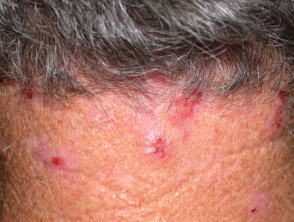What are delusions of parasitosis?
Delusions of parasitosis is a condition in which sufferers have a fixed, firm but erroneous belief that they are infested by living organisms such as lice, fleas, fungi, yeasts, worms, and even lizards.
It may be a primary condition, or secondary to other psychiatric conditions such as dementia, schizophrenia, depression, underlying medical conditions, recreational drug use, and prescribed medications. It is sometimes called delusional infestation, parasitophobia, psychogenic parasitosis, or Ekbom syndrome.
Who gets delusions of parasitosis?
It is uncommon; the incidence has been reported to be between 1.9 to 27.3 cases per 100,000 population. The average age of presentation is in the late 50s and early 60s. Some surveys have found a female predominance (2:1), and less common in those of skin of colour.
What causes delusions of parasitosis?
Primary delusions of parasitosis are of unknown cause, but is thought to be the result of an increase in dopamine within the basal ganglia of the brain.
Secondary delusions of parasitosis may be due to:
- Medical illnesses — hypothyroidism, vitamin B12 deficiency, neuropathy, and diabetes mellitus
- Neurological disease — dementia, stroke, multiple sclerosis, encephalitis
- Primary psychiatric disorders
- Infections — HIV, tuberculosis, leprosy, syphilis
- Recreational drug abuse — cocaine, amphetamines, and alcohol withdrawal [see Cutaneous effects of drugs of abuse]
- Medication — amantadine, l-dopa, topiramate, gabapentin, ropinirole, ketoconazole, ciprofloxacin, phenelzine, cetirizine and doxepin [see Antihistamines].
What are the clinical features of delusions of parasitosis?
Sufferers complain of crawling sensations under the skin, which will result in scratching and excoriations. They will find pieces of skin, crusts, and scabs, and interpret them as parasites, insects, or other living organisms.
They may complain of insects or worms appearing from their nose, ears, mouth, intestines, or genitalia.
They may have contacted the environmental health department and had their dwelling fumigated, and contacted several medical practitioners and entomologists.
Pets may have been dispatched to the vet for examination and treatment.
Other family members may have been convinced of the notion that they are infested and persuaded to apply insecticides and antiseptics.
Examination may show excoriations and ulcers from picking or gouging the skin to remove perceived parasites.
There may be an odour of antiseptics, disinfectants, and insecticides.
Specimens of skin and scabs may be brought as proof of their infestation (the 'matchbox sign').
Excoriations due to delusions of parasitosis
What are the complications of delusions of parasitosis?
- Anxiety and depression [see Psychosocial factors in dermatology]
- Suicide
- Irritant contact dermatitis
- Scars
- Side effects of antipsychotic medication (extrapyramidal side effects and dysrhythmias with first generation, weight gain with some second-generation agents)
How are delusions of parasitosis diagnosed?
- The diagnosis is confirmed from the patient’s assertion and fixed belief of being infested, in the absence of an infestation being identified. A careful skin examination and dermoscopy is needed to exclude infestation and other inflammatory dermatosis that may be causing itch.
- Carefully review medication history.
- Any specimens brought should be examined microscopically; it is helpful for laboratory microscopy to be undertaken so that the patient can be reassured by the pathological report.
Other laboratory tests should include:
- Full blood count, vitamin B12, ferritin
- Renal and liver function
- Thyroid function
- Urine screen for recreational drugs
- Consider the need for HIV and syphilis serology.
What is the differential diagnosis for delusions of parasitosis?
What is the treatment for delusions of parasitosis?
Often several consultations are required to gain trust, with repeat examinations of the skin, and any specimens offered. It is useful for the physician to express their concern for their distress, take time to listen to their complaints, and not be judgemental or dismissive. It can help to state that examination and microscopy “does not show any evidence of parasites today”. It is useful to explain that they have been able to help patients with similar symptoms in the past.
General measures
- Emollients and soap substitutes to minimise irritant dermatitis
- Paste bandages or hydrocolloid wound dressings to prevent further excoriations
- Topical antipruritics (menthol, crotamiton)
- Correct any identified metabolic abnormalities
- Stop or substitute any implicated medication
Specific measures
It is essential that there is no collusion with the patient, nor should the physician assert that the psychotropic drugs have “parasite killing” effects.
State that no parasites have been identified on microscopy and that these symptoms of crawling and itching are being interpreted by the brain as infestation, even though no parasites are evident, and that addressing these symptoms with medication will help.
Patients are often reluctant, and even refuse, to see psychiatrists. A remote liaison between the dermatologist and a psychiatrist can be helpful.
Symptoms of depression should be sought, as they may need specific treatment with a selective serotonin reuptake inhibitor.
Medications used include:
- First generation antipsychotics — pimozide. This was the treatment of choice, but the newer second-generation antipsychotics used at low dose have a better side effect profile and are preferred.
- Second generation antipsychotics — risperidone, olanzapine, quetiapine, aripiprazole.
Between 60 to 100% of patients are reported to significantly improve with antipsychotics.
See the British Association of Dermatologists guidelines for the management of adults with delusional infestation 2022 for more information on the use and dosages of antipsychotic medication.
What is the outcome for delusions of parasitosis?
Antipsychotic medication is needed for at least 6 months, and can be tapered down thereafter and discontinued according to symptom control. Symptoms may recur and medication may be needed intermittently.

